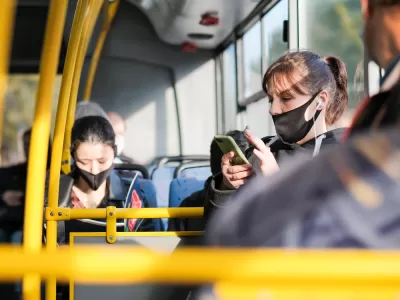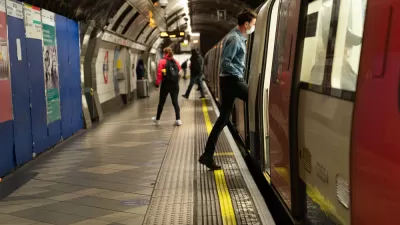Why is it hard for transit agencies to enforce pro-mask rules?

A few weeks ago, a certain relative of mine (who I shall call "R") was in a difficult situation. She got a part-time job, which required her to take a commuter train to Newark, New Jersey and a bus through the city of Newark to get to the job. She was not afraid to travel on the commuter train; it wasn’t very crowded, and people were generally wearing masks to reduce the risk of COVID-19 infection. But the bus was different; even though it was not enormously crowded, people were not always wearing masks, or were wearing them improperly, or were engaging in the sort of long cell phone conversations that are more likely to spread the virus. As a result, she quit the job.
Shortly afterwards, R asked me why the transit agency was not more aggressive about requiring riders to wear masks.* At first glance, this seems like an easy decision: if people are afraid to ride the bus because of unmasked riders, they won't. So why might a driver not enforce this rule?
First of all, agency every minute the bus driver spends arguing with riders is a minute more of delay that inconveniences people waiting for the bus. So the driver has to weigh two evils: the risk of infection from unmasked riders and the less dangerous, but more frequent, harm from sluggish buses.
Second, because talking loudly spreads the virus, arguing with riders also creates a public health risk: an argument means that a possibly-infected rider might talk even more and spread even more risk, and that a possibly-infected bus driver might talk and do the same. And since bus drivers might get closer to the rider in order to argue or to physically eject the rider, this too increases the risk of infection (because being ten feet from the rider is less risky than being two feet from the rider).
Third, if the rider is extremely unwilling to comply the driver might call the police to eject the rider—but this creates more risk in two ways. First, if the rider is infected the police might get infected as well. Second, if interactions become violent, that might cause someone to visit an emergency room, overburdening the health care system or even infecting doctors and nurses. Occasionally, violent interactions between police and citizens lead to riots, creating even more harm to a wide variety of persons.
Like many other rules, the "masks on buses" rule works only work if almost everyone is willing to comply without coercion. Once a critical mass of people decide to violate the rules, enforcement becomes extremely costly.
*One alternative might be to prominently post "how to wear a mask" notices. Although this would probably increase compliance with pro-mask rules, I suspect it would not lead to 100% compliance.

Trump Administration Could Effectively End Housing Voucher Program
Federal officials are eyeing major cuts to the Section 8 program that helps millions of low-income households pay rent.

Planetizen Federal Action Tracker
A weekly monitor of how Trump’s orders and actions are impacting planners and planning in America.

Canada vs. Kamala: Whose Liberal Housing Platform Comes Out on Top?
As Canada votes for a new Prime Minister, what can America learn from the leading liberal candidate of its neighbor to the north?

Washington State’s Parking Reform Law Could Unlock ‘Countless’ Acres for New Housing
A law that limits how much parking cities can require for residential amd commercial developments could lead to a construction boom.

Wildlife Rebounds After the Eaton Fire
Following the devastation of the Eaton Fire, the return of wildlife and the regrowth of native plants are offering powerful signs of resilience and renewal.

LA to Replace Inglewood Light Rail Project With Bus Shuttles
LA Metro says the change is in response to community engagement and that the new design will be ready before the 2028 Olympic Games.
Urban Design for Planners 1: Software Tools
This six-course series explores essential urban design concepts using open source software and equips planners with the tools they need to participate fully in the urban design process.
Planning for Universal Design
Learn the tools for implementing Universal Design in planning regulations.
Central Transportation Planning Staff/Boston Region MPO
Heyer Gruel & Associates PA
Institute for Housing and Urban Development Studies (IHS)
City of Grandview
Harvard GSD Executive Education
Regional Transportation Commission of Southern Nevada
Toledo-Lucas County Plan Commissions





























